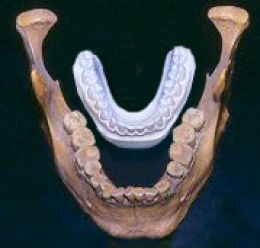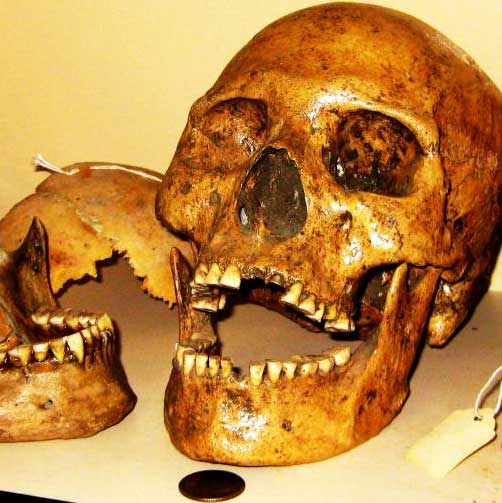
|
|||
Lovelock giant skull - Who Were The Si-Te-Cah
Source : Multiple Sources
In 1911 several giant skeletons and ancient artefacts were supposedly fund in a cave in Lovelock in Nevada, USA. Almost everything was later lost in a fire but a skull is supposed to be found in the Humbolt Museum, Winnemucca. Many Native American tribes from the Northeast and Southwest still relate the legends of the red-haired giants and how their ancestors fought terrible, protracted wars against the giants when they first encountered them in North America almost 15,000 years ago. It may surprise people that ancient artefacts were found in the Heartland America state of Nevada, but Native American tribes were spread throughout the American heartland. When mining for guano in a cave in Lovelock, a small town about 80 miles north-east of Reno, the miners reportedly found mummies preserved in the dry bat-droppings. The mummies were large, from 6 and a half feet to more that 8 feet (2 to more than 2,5 meters), and they had red hair. They were reportedly lying in a layer of burnt material about four feet under the surface and there were also lots of broken arrows around the mummies. Before archaeologists could survey the findings most of it was gone or damaged - and a later fire where the artefacts were stored did no good either. Legends The Puite Indians of the area have legends about giants and how they killed them. The race of giants, the "Si-Te-Cah" , should have been white, red-haired, very tall cannibals, and the Indians started war against them when they entered their land. A coalition of tribes managed to trap the last remaining giants in a cave and while shooting arrows at them they started a large fire at the mouth of the cave. They kept the fire going and shot everybody who tried to get out - until the giants were annihilated. The Paiutes, a Native-American tribe indigenous to parts of Nevada, Utah and Arizona, told early white settlers about their ancestors’ battles with a ferocious race of white, red-haired giants. According to the Paiutes, the giants were already living in the area. The Paiutes named the giants “Si-Te-Cah” that literally means “tule-eaters.” The tule is a fibrous water plant the giants wove into rafts to escape the Paiutes continuous attacks. They used the rafts to navigate across what remained of Lake Lahontan. According to the Paiutes, the red-haired giants stood as tall as 12-feet and were a vicious, unapproachable people that killed and ate captured Paiutes as food. The Paiutes told the early settlers that after many years of warfare, all the tribes in the area finally joined together to rid themselves of the giants. One day as they chased down the few remaining red-haired enemy, the fleeing giants took refuge in a cave. The tribal warriors demanded their enemy come out and fight, but the giants steadfastly refused to leave their sanctuary.  According to Paiute oral history, the Si-Te-Cah are a legendary tribe whose mummified remains were discovered (under four feet of guano) by miners in what is now known as “Lovelock Cave” in Lovelock, Nevada, United States. Although the cave had been mined since 1911, it was not until 1912 when miners notified authorities. An archeological excavation ensued producing 10,000 artifacts. "Si-Te-Cah" literally means “tule-eaters” in the language of the Paiute Indians. Tule is a fibrous water plant. In order to escape harassment from the Paiutes, the Si-Te-Cahs were said to have lived on rafts made of tule on the lake. According to the Paiutes, the Si-Te-Cah were a hostile and warlike tribe who practiced cannibalism. The Si-Te-Cah and the Paiutes were at war, and after a long struggle a coalition of tribes trapped the remaining Si-Te-Cah in Lovelock Cave. When they refused to come out, the Indians piled brush before the cave mouth and set it aflame. The Si-Te-Cah were annihilated.
Among the artifacts found were woven cloth, tools, duck decoys (for hunting), inscribed stones, and supposedly, 12-foot-tall red-haired mummies. Thousands of pieces were found discarded outside the cave after being separated from the guano. Most of the non-human artifacts can be found in local museums or at the University of California at Berkeley museum, but the mysterious bones and mummies are not so easy to come by. The artifacts, themselves, prove that an advanced culture did indeed predate the Paiute Indians, but whether the legend of red-haired giants is historically accurate remains unknown. Trying to see these mummies for yourself, you’ll only get the run-around. One museum will tell you the other has it, and vice versa, ad infinitum. The original miners and excavators claim that several mummies (partial and whole) were unearthed, but nowadays, all you can see for sure are one jawbone and one misshapen skull. The Humboldt County Museum in Winnemucca has one of the skulls. Whether the Lovelock Cave mummies ever really existed or were deliberately covered up, we may never know. The existing artifacts do seem to substantiate the Paiute legend, and evidence of gigantism has been discovered, and documented, in other places across the planet. The Lovelock Cave claim seems to have all the vital pieces–except for the giant mummies themselves. Were they hidden away in some warehouse, so humanity wouldn’t see the errors of modern history? Or, were they the imaginary compilation of an ancient legend and a few mysterious bones? Sarah Winnemucca Hopkins, daughter of Paiute Chief Winnemucca, related many stories about the Si-Te-Cah in her book Life Among the Paiutes. "My people say that the tribe we exterminated had reddish hair. I have some of their hair, which has been handed down from father to son. I have a dress which has been in our family a great many years, trimmed with the reddish hair. I am going to wear it some time when I lecture. It is called a mourning dress, and no one has such a dress but my family." (Hopkins, page 75). Adrienne Mayor writes about the Si-Te-Cah in her book Fossil Legends of the First Americans. She suggests that the 'giant' interpretation of the skeletons from Lovelock Cave and other dry caves in Nevada was started by entrepreneurs setting up tourist displays and that the skeletons themselves were of normal size. However, about a hundred miles north of Lovelock there are plentiful fossils of mammoths and cave bears, and their large limb bones could easily be thought to be those of giants by an untrained observer. She also discusses the reddish hair, pointing out that hair pigment is not stable after death and that various factors such as temperature, soil, etc. can turn ancient very dark hair rusty red or orange, though it may not account for the Paiute tradition of red-haired people existing here before the cave was excavated. Another explanation for the 'giant' interpretation of the skeletons may also come from the fact that some of the first remains unearthed by the guano miners in 1911-12 were described as “giant". A written report by James H. Hart, the first of two miners to excavate the cave in the fall of 1911, recalls that in the north-central part of the cave, about four feet deep, "was a striking looking body of a man “six feet six inches tall.” His body was mummified and his hair distinctly red." (Loud & Harrington, page 87). Unfortunately in the first year of mining, some of the human remains and artifacts were lost and destroyed. "The best specimen of the adult mummies was boiled and destroyed by a local fraternal lodge, which wanted the skeleton for initiation purposes." (Loud & Harrington, page 5). Also, several of the fiber sandals found in the cave were remarkably large, and one reported at over 15 inches (38 cm) in length was said to be on display at the Nevada Historical Society's museum in Reno in 1952. The Paiute tradition asserts that the Si-Te-Cah people practiced cannibalism, and this may have had some basis in fact. During the 1924 excavation of the cave, a series of three human bones were found near the surface towards the mouth of the cave. "These had been split to extract the marrow, as animal bones were split, and probably indicate cannibalism during a famine." comments powered by Disqus Submit News/Videos/Links | Discuss article | Article Link | More Unsolved and Unexplained Mysteries |
More can be addded on request. Direct your requests at vinit@theunexplainedmysteries.com
